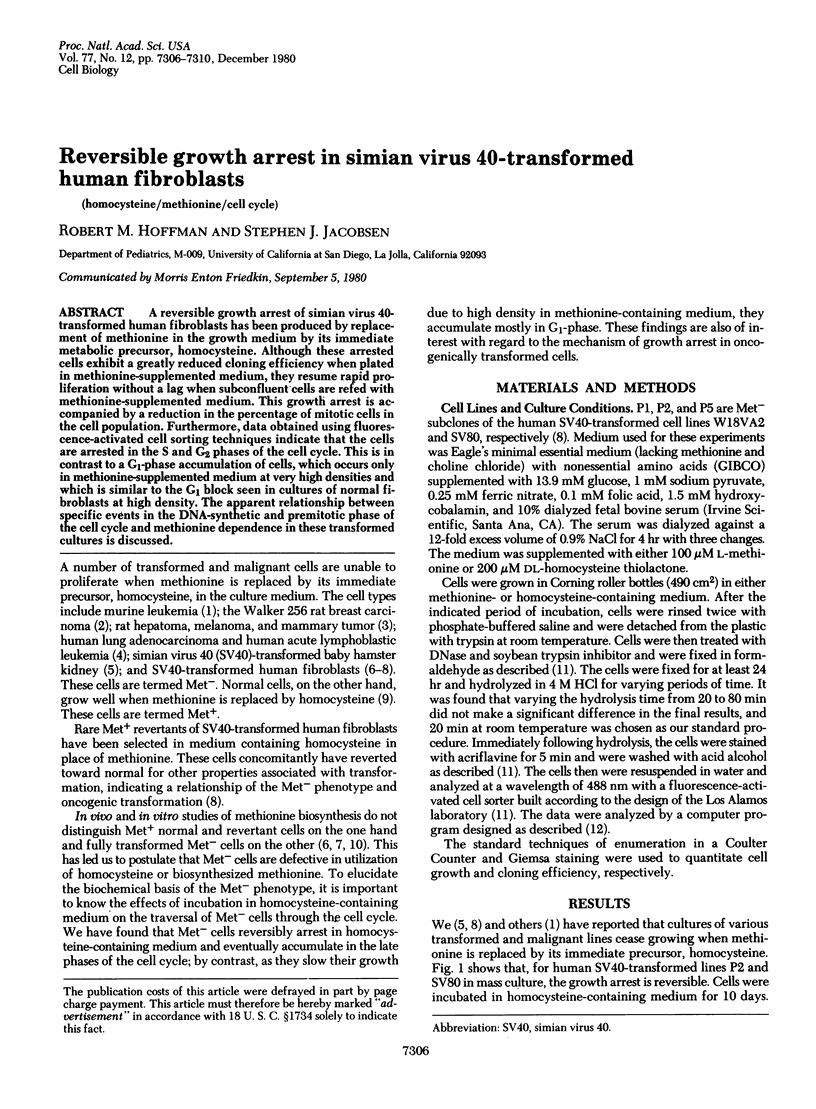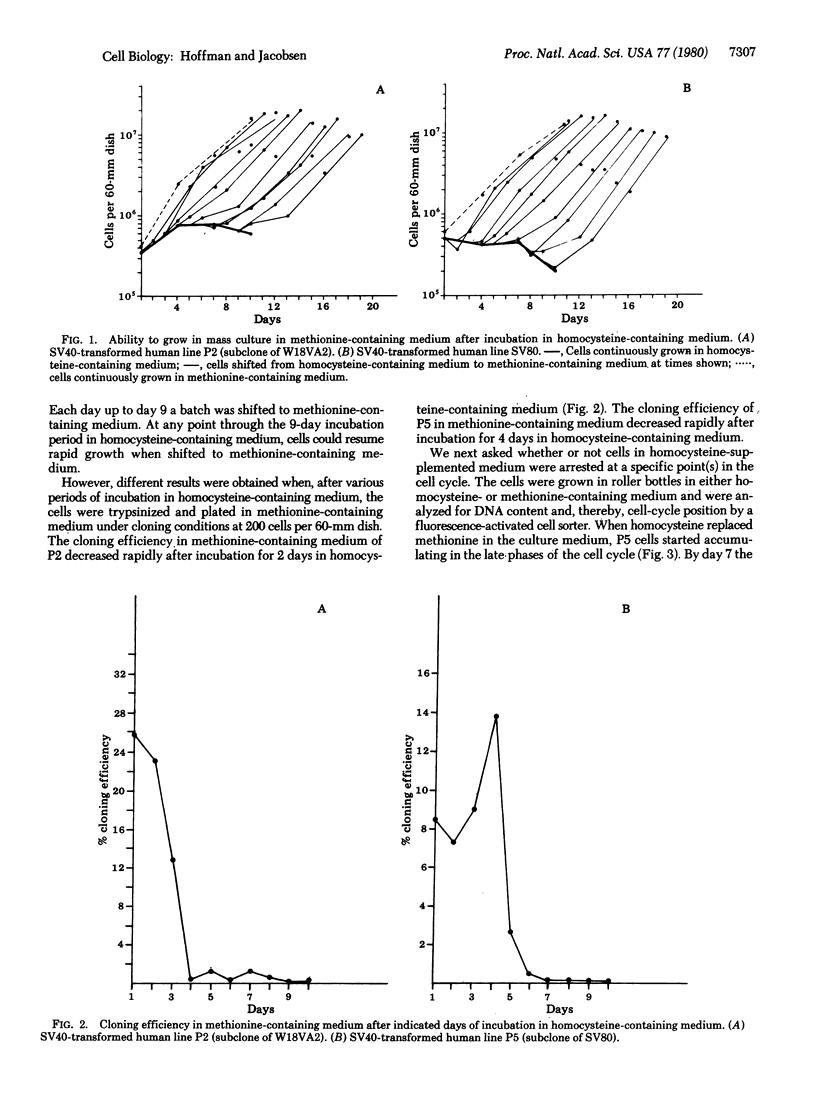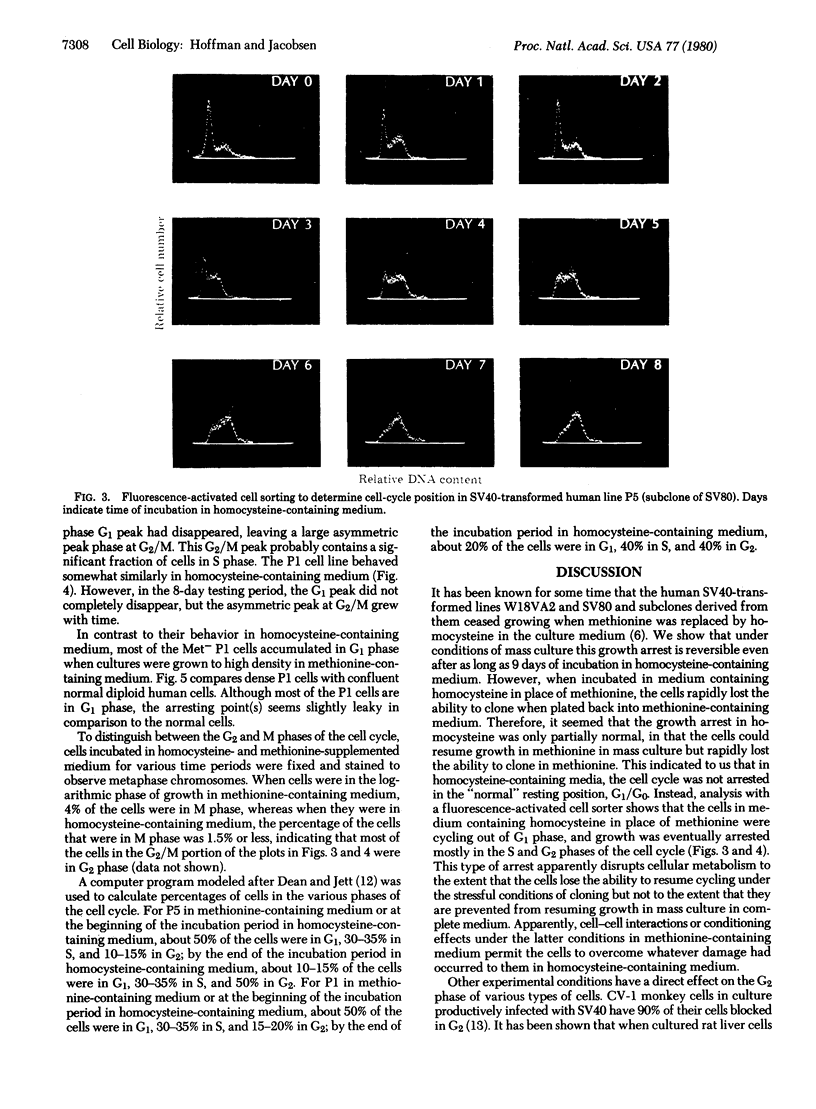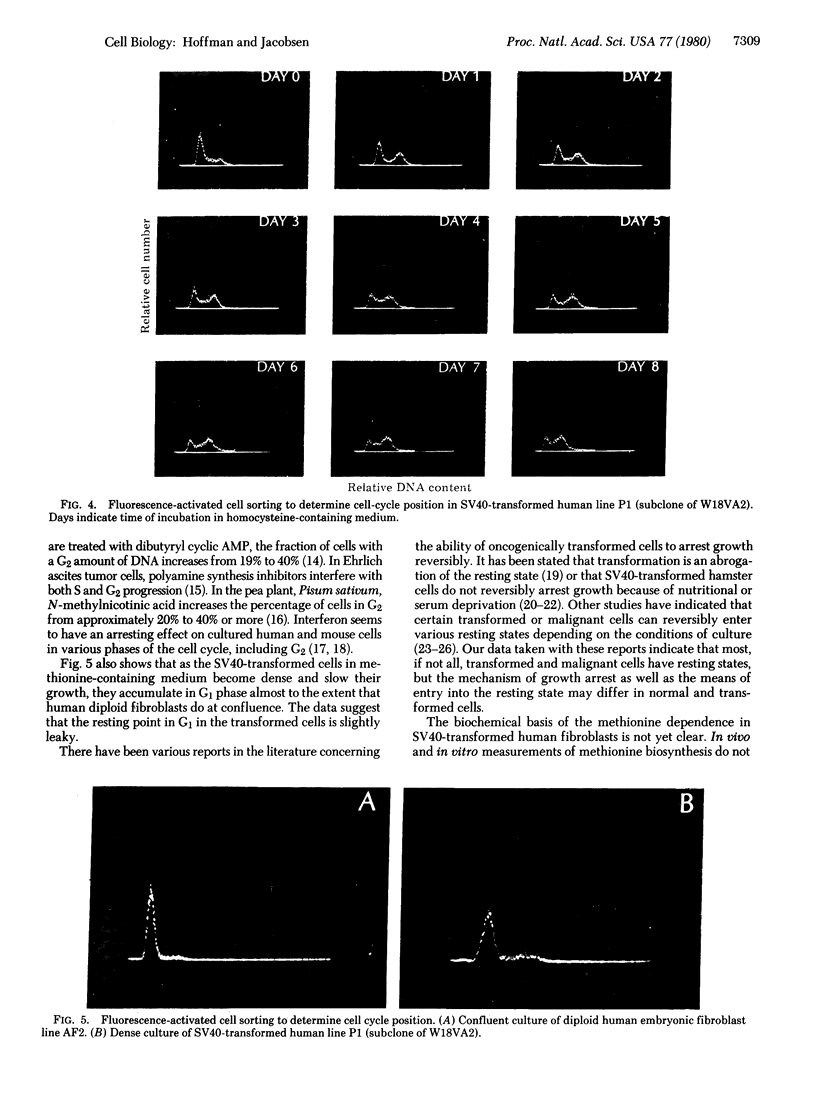Abstract
A reversible growth arrest of simian virus 40-transformed human fibroblasts has been produced by replacement of methionine in the growth medium by its immediate metabolic precursor, homocysteine, Although these arrested cells exhibit a greatly reduced cloning efficiency when plated in methionine-supplemented medium, they resume rapid proliferation without a lag when subconfluent cells are refed with methionine-supplemented medium. This growth arrest is accompanied by a reduction in the percentage of mitotic cells in the cell population. Furthermore, data obtained using fluorescence-activated cell sorting techniques indicate that the cells are arrested i the S and G2 phases of the cell cycle. This is in contrast to a G1-phase accumulation of cells, which occurs only in methionine-supplemented medium at very high densities and which is similar to the G1 block seen in cultures of normal fibroblasts at high density. The apparent relationship between specific events in the DNA-synthetic and premitotic phase of the cell cycle and methionine dependence in these transformed cultures is discussed.
Full text
PDF




Images in this article
Selected References
These references are in PubMed. This may not be the complete list of references from this article.
- Balińska M., Grzelakowska-Sztabert B. Biosynthesis of methionine in mouse cells cultured in vitro. Biochem Biophys Res Commun. 1978 Dec 14;85(3):1165–1172. doi: 10.1016/0006-291x(78)90664-2. [DOI] [PubMed] [Google Scholar]
- Balkwill F., Taylor-Papadimitriou J. Interferon affects both G1 and S+G2 in cells stimulated from quiescence to growth. Nature. 1978 Aug 24;274(5673):798–800. doi: 10.1038/274798a0. [DOI] [PubMed] [Google Scholar]
- Baltimore D. Tumor viruses: 1974. Cold Spring Harb Symp Quant Biol. 1975;39(Pt 2):1187–1200. doi: 10.1101/sqb.1974.039.01.137. [DOI] [PubMed] [Google Scholar]
- Chello P. L., Bertino J. R. Dependence of 5-methyltetrahydrofolate utilization by L5178Y murine leukemia cells in vitro on the presence of hydroxycobalamin and transcobalamin II. Cancer Res. 1973 Aug;33(8):1898–1904. [PubMed] [Google Scholar]
- Cherington P. V., Smith B. L., Pardee A. B. Loss of epidermal growth factor requirement and malignant transformation. Proc Natl Acad Sci U S A. 1979 Aug;76(8):3937–3941. doi: 10.1073/pnas.76.8.3937. [DOI] [PMC free article] [PubMed] [Google Scholar]
- Creasey A. A., Bartholomew J. C., Merigan T. C. Role of G0-G1 arrest in the inhibition of tumor cell growth by interferon. Proc Natl Acad Sci U S A. 1980 Mar;77(3):1471–1475. doi: 10.1073/pnas.77.3.1471. [DOI] [PMC free article] [PubMed] [Google Scholar]
- Dean P. N., Jett J. H. Mathematical analysis of DNA distributions derived from flow microfluorometry. J Cell Biol. 1974 Feb;60(2):523–527. doi: 10.1083/jcb.60.2.523. [DOI] [PMC free article] [PubMed] [Google Scholar]
- Evans L. S., Almeida M. S., Lynn D. G., Nakanishi K. Chemical characterization of a hormone that promotes cell arrest in g2 in complex tissues. Science. 1979 Mar 16;203(4385):1122–1123. doi: 10.1126/science.203.4385.1122. [DOI] [PubMed] [Google Scholar]
- Gershey E. L. Simian virus 40-host cell interaction during lytic infection. J Virol. 1979 Apr;30(1):76–83. doi: 10.1128/jvi.30.1.76-83.1979. [DOI] [PMC free article] [PubMed] [Google Scholar]
- Halpern B. C., Clark B. R., Hardy D. N., Halpern R. M., Smith R. A. The effect of replacement of methionine by homocystine on survival of malignant and normal adult mammalian cells in culture. Proc Natl Acad Sci U S A. 1974 Apr;71(4):1133–1136. doi: 10.1073/pnas.71.4.1133. [DOI] [PMC free article] [PubMed] [Google Scholar]
- Heby O., Andersson G., Gray J. W. Interference with S and G2 phase progression by polyamine synthesis inhibitors. Exp Cell Res. 1978 Feb;111(2):461–464. doi: 10.1016/0014-4827(78)90192-1. [DOI] [PubMed] [Google Scholar]
- Hoffman R. M., Erbe R. W. High in vivo rates of methionine biosynthesis in transformed human and malignant rat cells auxotrophic for methionine. Proc Natl Acad Sci U S A. 1976 May;73(5):1523–1527. doi: 10.1073/pnas.73.5.1523. [DOI] [PMC free article] [PubMed] [Google Scholar]
- Hoffman R. M., Jacobsen S. J., Erbe R. W. Reversion to methionine independence by malignant rat and SV40-transformed human fibroblasts. Biochem Biophys Res Commun. 1978 May 15;82(1):228–234. doi: 10.1016/0006-291x(78)90600-9. [DOI] [PubMed] [Google Scholar]
- Hoffman R. M., Jacobsen S. J., Erbe R. W. Reversion to methionine independence in simian virus 40-transformed human and malignant rat fibroblasts is associated with altered ploidy and altered properties of transformation. Proc Natl Acad Sci U S A. 1979 Mar;76(3):1313–1317. doi: 10.1073/pnas.76.3.1313. [DOI] [PMC free article] [PubMed] [Google Scholar]
- Holley R. W., Baldwin J. H., Kiernan J. A., Messmer T. O. Control of growth of benzo(a)pyrene-transformed 3T3 cells. Proc Natl Acad Sci U S A. 1976 Sep;73(9):3229–3232. doi: 10.1073/pnas.73.9.3229. [DOI] [PMC free article] [PubMed] [Google Scholar]
- Jacobsen S. J., North J. A., Rao N. A., Mangum J. H. 5-methyltetrahydrofolate: synthesis and utilization in normal and SV40-transformed BHK-21 cells. Biochem Biophys Res Commun. 1977 May 9;76(1):46–53. doi: 10.1016/0006-291x(77)91666-7. [DOI] [PubMed] [Google Scholar]
- Kamely D., Littlefield J. W., Erbe R. W. Regulation of 5-methyltetrahydrofolate: homocysteine methyltransferase activity by methionine, vitamin B12, and folate in cultured baby hamster kidney cells. Proc Natl Acad Sci U S A. 1973 Sep;70(9):2585–2589. doi: 10.1073/pnas.70.9.2585. [DOI] [PMC free article] [PubMed] [Google Scholar]
- Kreis W., Goodenow M. Methionine requirement and replacement by homocysteine in tissue cultures of selected rodent and human malignant and normal cells. Cancer Res. 1978 Aug;38(8):2259–2262. [PubMed] [Google Scholar]
- Martin R. G., Stein S. Resting state in normal and simian virus 40 transformed Chinese hamster lung cells. Proc Natl Acad Sci U S A. 1976 May;73(5):1655–1659. doi: 10.1073/pnas.73.5.1655. [DOI] [PMC free article] [PubMed] [Google Scholar]
- Moses H. L., Proper J. A., Volkenant M. E., Wells D. J., Getz M. J. Mechanism of growth arrest of chemically transformed cells in culture. Cancer Res. 1978 Sep;38(9):2807–2812. [PubMed] [Google Scholar]
- Naylor S. L., Busby L. L., Klebe R. J. Biochemical selection systems for mammalian cells: the essential amino acids. Somatic Cell Genet. 1976 Mar;2(2):93–111. doi: 10.1007/BF01542624. [DOI] [PubMed] [Google Scholar]
- Nose K., Katsuta H. Arrest of cultured rat liver cells in G2 phase by the treatment with dibutyryl cAMP. Biochem Biophys Res Commun. 1975 Jan 2;64(3):983–988. doi: 10.1016/0006-291x(75)90144-8. [DOI] [PubMed] [Google Scholar]
- Pardee A. B. A restriction point for control of normal animal cell proliferation. Proc Natl Acad Sci U S A. 1974 Apr;71(4):1286–1290. doi: 10.1073/pnas.71.4.1286. [DOI] [PMC free article] [PubMed] [Google Scholar]
- Pardee A. B., James L. J. Selective killing of transformed baby hamster kidney (BHK) cells. Proc Natl Acad Sci U S A. 1975 Dec;72(12):4994–4998. doi: 10.1073/pnas.72.12.4994. [DOI] [PMC free article] [PubMed] [Google Scholar]






